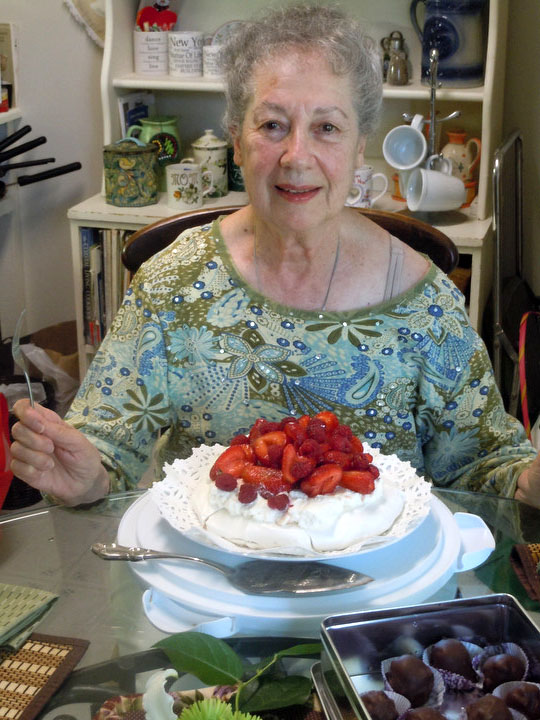 [W]hen I first began conversing with Al Dente Floyd at work, he gave me his mother’s phone number, saying, “Since you do the food thing, you might want to talk to her — she has a lot of recipes.â€
[W]hen I first began conversing with Al Dente Floyd at work, he gave me his mother’s phone number, saying, “Since you do the food thing, you might want to talk to her — she has a lot of recipes.â€
But, he admonished, “Whatever you do, DON’T talk to her about the ballet.â€
What?!?!
Al Dente had revealed that his mother had been a ballerina with the prestigious company, Ballet Russes, in the 1950s, and I was not supposed to talk to her about that? I, like many a girl, had over the years my own fascination with dance and dancers and was to speak to a real live ballerina and not talk of it. Perhaps it was upsetting to her.
“Why?†I asked, waiting to hear of some tragedy, that the mere mention of ballet to his mother would give her to collapse.
“Once she starts talking about it, she won’t stop.†He rolled his eyes. OK, I got it. Al Dente had had a lifetime of ballet, ballet talk and even (I would come to learn) his own “Billy Elliot†period, which he would just as soon forget. So for him, this worn subject was closed. For me, it was all new. And as equally interested as I was to learn of Libby’s skills as a cook of Italian heritage, there was no way I would be skipping the topic of ballet. I just couldn’t expect Al Dente to be patient enough to join in.
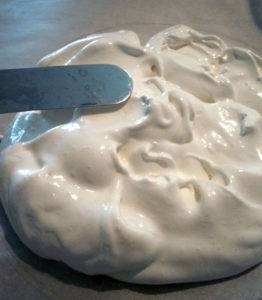 The first afternoon I spent with Liboria “Libby†Salerno in her small senior apartment, I brought the former ballerina what I believed to be the ultimate dancer treat — a Pavlova, which is a fluffy meringue, resembling a tutu, topped with whipped cream and berries. The dessert,created for the famous dancer, Anna Pavlova, is both elegant and rustic. Making a Pavlova is a bit of an effort and a mystery. It involves meringue, which is always tempestuous, getting the gloss and thickness just right, and said meringue in this delicate baked disk rendition, tends to crack, but that’s exactly what it’s supposed to do. I drove the pale, semi-frail creature carefully in my car, along with its topping of whipped cream and berries, and assembled the whole dessert at Libby’s place. I also made a couple of other treats — chocolate truffles and lavender shortbread — that we enjoyed with some Pellegrino sparkling water. Having recently celebrated her June birthday, the 80-something, declared this, too, was a part of the festivities.
The first afternoon I spent with Liboria “Libby†Salerno in her small senior apartment, I brought the former ballerina what I believed to be the ultimate dancer treat — a Pavlova, which is a fluffy meringue, resembling a tutu, topped with whipped cream and berries. The dessert,created for the famous dancer, Anna Pavlova, is both elegant and rustic. Making a Pavlova is a bit of an effort and a mystery. It involves meringue, which is always tempestuous, getting the gloss and thickness just right, and said meringue in this delicate baked disk rendition, tends to crack, but that’s exactly what it’s supposed to do. I drove the pale, semi-frail creature carefully in my car, along with its topping of whipped cream and berries, and assembled the whole dessert at Libby’s place. I also made a couple of other treats — chocolate truffles and lavender shortbread — that we enjoyed with some Pellegrino sparkling water. Having recently celebrated her June birthday, the 80-something, declared this, too, was a part of the festivities.
 She is the octogenarian we all would hope to be — excited, curious, active and still moving with the ease and grace that must have made her a wonderful dancer. She keeps her long curly hair coiled in a bun on her head, and she keeps herself in good condition (on a subsequent visit, Libby was wearing shorts and I remarked that I could see her legs. “Here they are!” she yelled and swiftly kicked one high above her head).
She is the octogenarian we all would hope to be — excited, curious, active and still moving with the ease and grace that must have made her a wonderful dancer. She keeps her long curly hair coiled in a bun on her head, and she keeps herself in good condition (on a subsequent visit, Libby was wearing shorts and I remarked that I could see her legs. “Here they are!” she yelled and swiftly kicked one high above her head).
Al Dente joined us for the food (of course), then conveniently excused himself, as I’m sure he sensed the impending dance discussion about to unfold.
Six hours later, I left Libby, a little numb and dizzy from my ballet crash-course intensive. We had watched ballet videos, gone through her ballet scrapbooks, talked technique (she was schooled in the Cechetti method) and discussed both known and little-known ballet legends, such as Alicia Alonso, a Cuban dancer, who, facing blindness underwent an eye surgery and recovery that kept her in bed, immobilized, but still practicing her art by moving her feet and fingers to keep the choreography alive as she fought to keep her eyesight.Â
Libby grew up in Northern California, and was called to the dance — or at least, as the story goes, inserted herself — at the age of two, when she stole the show at her older sister’s dance lessons . She toured all over the country with New York-based Ballet Russes in the 1950s, but left to start a family. In the creative years that followed, Libby ran a ballet school and a children’s theatre program.
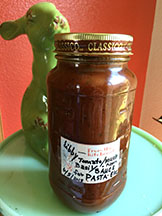 That afternoon, I also got a taste of Libby’s other passion — food. She has an amazing recipe collection and makes her own pasta sauce and pesto that she shares (she gave me ideas of how to use it and said, “You can even just dip your finger in it when you feel like it.â€). She apparently makes unmatched short ribs ( I have yet to try) and lasagne that is layered thick with sauce and shredded chuck roast.
That afternoon, I also got a taste of Libby’s other passion — food. She has an amazing recipe collection and makes her own pasta sauce and pesto that she shares (she gave me ideas of how to use it and said, “You can even just dip your finger in it when you feel like it.â€). She apparently makes unmatched short ribs ( I have yet to try) and lasagne that is layered thick with sauce and shredded chuck roast.
Sometimes you can tell early when a match is made. Was it because I was an eager listener to an avid talker, with stories that had many beginnings and no end (and sometimes no awareness of what the story had started out about to begin with)? Was it because I was drawn, like a moth to a flame, to those who are passionately energetic (I myself a little too subdued and willing to give in) or that I had a long-held secret wish to be Italian myself? And learn the secrets of Italians, who really know how to live and eat? And food, food, food — I had become convinced it always brought me to the ones I was supposed to know.
What I know for certain is that the moment Libby called me (without prompt) “Becky,†and a little familial thunderbolt shook me and I heard my late grandmother’s voice, I knew I was supposed to become close to this little woman. For it is only family — or those who feel that kind of comfortable closeness — who call me by my childhood name.
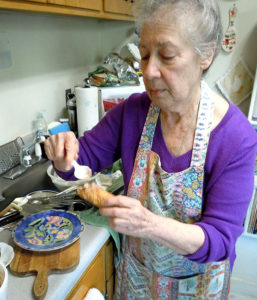 So, rarely attached to anyone, attached I was, and I have ventured Libby’s way periodically and regularly. She made a St. Patrick’s Day feast of corned beef and cabbage, and I added an apple scone cake. She made a Christmastime brunch, and I brought her a homemade Italian Panettone. She made true authentic meatballs and sauce and showed me how to make cannoli (she insists upon freshly made shells, not the packaged versions) into which she loaded both chocolate-flavored and ricotta fillings. Even when we planned a trip to Napa to get gelato, Libby laid out a spread of roast beef sandwiches beforehand. Always, the table is dressed elegantly with pretty plates and cloth napkins. Always, Libby glides the short journey elegantly and happily back and forth between the small kitchen and the large dining table.
So, rarely attached to anyone, attached I was, and I have ventured Libby’s way periodically and regularly. She made a St. Patrick’s Day feast of corned beef and cabbage, and I added an apple scone cake. She made a Christmastime brunch, and I brought her a homemade Italian Panettone. She made true authentic meatballs and sauce and showed me how to make cannoli (she insists upon freshly made shells, not the packaged versions) into which she loaded both chocolate-flavored and ricotta fillings. Even when we planned a trip to Napa to get gelato, Libby laid out a spread of roast beef sandwiches beforehand. Always, the table is dressed elegantly with pretty plates and cloth napkins. Always, Libby glides the short journey elegantly and happily back and forth between the small kitchen and the large dining table.  And almost always — unless her son squelches her — she calls guests to the table with famed Italian cook Lidia Bastianich’s signature phrase, “Tutti a tovala a mangiare!†or “Everyone to the table to eat!â€
And almost always — unless her son squelches her — she calls guests to the table with famed Italian cook Lidia Bastianich’s signature phrase, “Tutti a tovala a mangiare!†or “Everyone to the table to eat!â€
One of my favorite trips to Libby’s table was a late spring lunch. Al Dente, who now owns and lives on the property built by Libby’s father, Sebastiano, had inherited his grandfather’s green thumb and tended the artichokes planted in the 1940s when the place was new. Still productive and fruitful, the ‘chokes are put to use by Al Dente almost every year, but he allows them to reach full bloom every three to five years for their health.
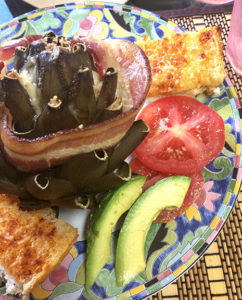 Al Dente also inherited his mother’s love of food and cooking and he prepares many dishes he learned from her and other family. Our lunch was a festive feast of Al Dente’s stuffed artichokes, Libby’s simple yet amazing garlic bread (you will find this recipe in second blog entry of 6/16), sliced avocados and tomatoes. I brought a Meyer lemon poundcake for dessert.
Al Dente also inherited his mother’s love of food and cooking and he prepares many dishes he learned from her and other family. Our lunch was a festive feast of Al Dente’s stuffed artichokes, Libby’s simple yet amazing garlic bread (you will find this recipe in second blog entry of 6/16), sliced avocados and tomatoes. I brought a Meyer lemon poundcake for dessert.
Al Dente clipped the pointy ends of the artichokes and embellished them with whole garlic cloves, bacon, bread crumbs, olive oil and Parmesan cheese.
Libby and son, who is approximately twice her height, worked side by side in the small kitchen. She, assembling the goodies for her garlic bread, and he, peeling one of this favorite things — garlic.
 In about an hour and a half, Libby poked the artichokes with a fork to test doneness, and soon we were gathered, as good friends and adopted family members do, to eat and enjoy company and conversation.
In about an hour and a half, Libby poked the artichokes with a fork to test doneness, and soon we were gathered, as good friends and adopted family members do, to eat and enjoy company and conversation.
If you’ve never eaten an artichoke in its full flower form, you should try it sometime. It is slow food. You cannot just gobble it down and run. Each tender petal is separated from the flower (and if you’re lucky, a roasted garlic clove accompanies it). The small, tender, buttery “meat†at the base of each petal is pulled off through the teeth.You savor each petal slowly and fully and you don’t hurry, because life is a long, lively story with — we hope — no ending.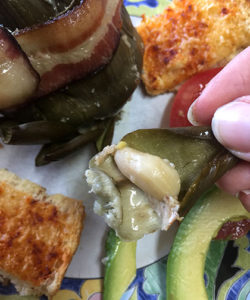
Artichokes Paolo
Serves 4
4 whole artichokes, rinsed and petals trimmed with points removed
40 whole garlic cloves, peeled
4 strips of bacon
1 cup bread crumbs (plain or Italian-seasoned)
1 cup shredded Parmesan cheese
Olive oil
Preheat oven to 350 degrees. Trim stems from bottoms of artichokes so they have an even bottom surface. Place artichokes in a glass casserole dish that has a lid (or you could cover them with foil before baking). Distribute garlic cloves evenly among artichokes by tucking them behind petals. Drizzle olive oil over each artichoke. Sprinkle with bread crumbs on top of each artichoke and so that they fall down behind and between artichoke petals. Drape a strip of bacon on each artichoke (wrap around like a garland), or chop bacon into chucks and place around petals. Sprinkle each with Parmesan cheese. Cover casserole and bake 60 to 90 minutes (begin checking at one hour) until fork tender.
Pavlova
From “The Joy of Baking†www.joyofbaking.com
Serves 6 to 8
Pavlova :
4 large egg whites
1 cup superfine (castor) sugar
1/2 teaspoon pure vanilla extract
1 teaspoon white vinegar
1/2 tablespoon cornstarch (corn flour)
Topping:
1 cup heavy whipping cream
1 1/2 tablespoons granulated white sugar (or to taste)
1/2 teaspoon pure vanilla extract
Fresh fruit – kiwi, strawberries, raspberries, blackberries, passion fruit, peaches, pineapple, or other fruit of your choice
Pavlova:Â Preheat oven to 250 degrees F (130 degrees C) and place rack in center of oven. Line a baking sheet with parchment paper and draw a 7 inch circle on the paper. Turn the parchment paper over so the circle is on the reverse side.
In the bowl of your electric mixer with the whisk attachment, beat the egg whites on medium speed until they hold soft peaks. Start adding the sugar, a tablespoon at a time, and continue to beat, on high speed, until the meringue holds very stiff and shiny peaks. (Test to see if the sugar is fully dissolved by rubbing a little of the meringue between your thumb and index finger. The meringue should feel smooth, not gritty. If it feels gritty the sugar has not fully dissolved so keep beating until it feels smooth between your fingers).
Beat in the vanilla extract. Sprinkle the vinegar and cornstarch over the top of the meringue and, with a rubber spatula, gently fold in. Spread the meringue inside the circle drawn on the parchment paper, smoothing the edges, making sure the edges of the meringue are slightly higher than the center. (You want a slight well in the center of the meringue to place the whipped cream and fruit.)
Bake for 60 to 75 minutes or until the outside is dry and is a very pale cream color. Turn the oven off, leave the door slightly ajar, and let the meringue cool completely in the oven. (The outside of the meringue will feel firm to the touch, if gently pressed, but as it cools you will get a little cracking and you will see that the inside is soft and marshmallowy.)
The cooled meringue can be made and stored in a cool dry place, in an airtight container, for a few days.
Just before serving gently place the meringue onto a serving plate. Whip the cream in your electric mixer, with the whisk attachment, until soft peaks form. Sweeten with the sugar and vanilla and then mound the softly whipped cream into the center of the meringue.
Arrange the fruit randomly, or in a decorative pattern, on top of the cream. Serve immediately as this dessert does not hold for more than a few hours.
Blogger’s Note: I have found that to get the best meringue, separate egg yolks from whites while the eggs are cold; let the whites come to room temperature before whipping into meringue.
For the “Garlic Bread a la Liboria†recipe, please read my other blog entry this month!